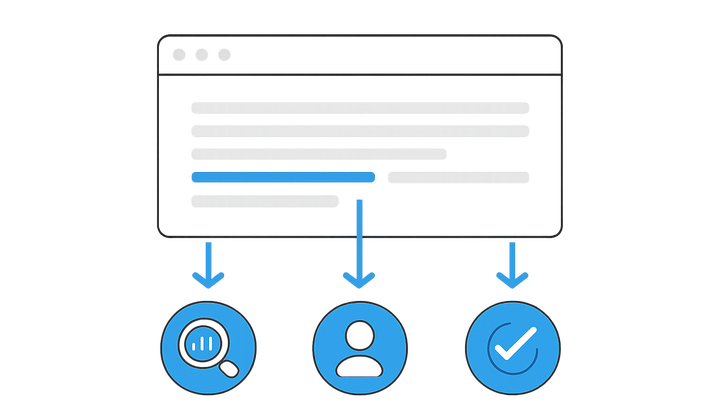Published on 2025-06-29T21:16:50Z
What Is Anchor Text? Examples and Best Practices
In web design and SEO, anchor text is the visible, clickable text portion of a hyperlink. It serves as a succinct descriptor for the destination page, providing both users and search engines with context about the linked content. Properly optimized anchor text can boost your site’s SEO by signaling keyword relevance and distributing link equity effectively. From a UX and accessibility standpoint, clear and descriptive anchor text helps users—especially those using screen readers—understand the purpose of the link before they click. In the realm of CRO (Conversion Rate Optimization), well-crafted anchor text can guide visitors toward desired actions and improve click-through rates. Tools like Prevue.me automatically audit your anchor text usage, flagging vague or repetitive phrases and offering actionable suggestions to enhance both SEO performance and user engagement.
Anchor text
Clickable link text that defines the linked page’s topic, guiding users and search engines, and influencing SEO, UX, and conversions.
Understanding Anchor Text
Overview of the concept and its role in digital marketing.
-
Definition
Anchor text is the visible, clickable text in a hyperlink that people and search engines see.
-
Types of anchor text
Common categories of anchor text based on keyword usage and format.
- Exact match:
Anchor text that exactly matches the target keyword phrase.
- Partial match:
Contains a variation or part of the target keyword.
- Branded:
Uses the brand or company name as anchor text.
- Generic:
Uses generic phrases like ‘click here’ or ‘learn more.’
- Naked url:
The URL itself is used as the anchor text.
- Exact match:
-
Html example
A basic anchor tag in HTML:
<a href="https://example.com">Example Site</a>
Why Anchor Text Matters for CRO, UX, and SEO
Examines how anchor text influences search engine rankings, user experience, and conversion rates.
-
Seo impact
Proper anchor text signals relevance and distributes link equity, improving search engine visibility.
-
User experience & accessibility
Descriptive anchor text helps users, including those using assistive technologies, understand link destinations.
-
Conversion optimization
Clear and persuasive anchor text encourages clicks, guiding users toward conversion goals.
Best Practices for Crafting Effective Anchor Text
Guidelines to optimize anchor text for clarity, relevance, and performance.
-
Be descriptive and relevant
Ensure anchor text accurately reflects the content of the linked page.
-
Use keywords strategically
Incorporate keywords naturally without overstuffing or forcing them.
-
Maintain accessibility
Avoid vague phrases; use meaningful text that screen readers can interpret correctly.
-
Optimize link placement
Position links where they provide the most context, such as within informative sentences.
Common Mistakes and How to Avoid Them
Pitfalls to watch out for when using anchor text.
-
Over-optimization and keyword stuffing
Using exact-match keywords excessively can trigger search engine penalties.
-
Generic phrases
Avoid generic anchors like ‘click here’ that provide no context.
-
Broken or misleading links
Ensure your anchor text corresponds to the actual destination to maintain trust.
Analyzing Anchor Text with Prevue.me
How prevue.me evaluates and improves your anchor text for optimal results.
-
Automated audits
prevue.me scans your site to identify weak or repetitive anchor text instances.
-
Actionable recommendations
Receive specific suggestions to enhance relevance, diversity, and clarity of your anchor text.
-
Monitoring and reporting
Track changes and improvements over time with dashboard reports.
